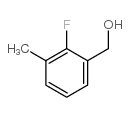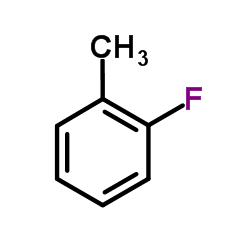151412-12-3
| 中文名 | 1-(溴甲基)-2-氟-3-甲基苯 |
|---|---|
| 英文名 | 2-fluoro-3-methylbenzyl bromide |
| 中文别名 | 2-氟-3-甲基苯甲基溴 |
| 英文别名 |
1-(bromomethyl)-2-fluoro-3-methylbenzene
2-Fluoro-3-methylbenzyl bromide MFCD00042470 |
| 沸点 | 168-109ºC (15 torr) |
|---|---|
| 分子式 | C8H8BrF |
| 分子量 | 203.05200 |
| 闪点 | 84.5ºC |
| 精确质量 | 201.97900 |
| LogP | 3.02900 |
| 外观性状 | 透明无色至淡黄色液体 |
| 折射率 | 1.5465-1.5495 |
| 储存条件 | 室温,干燥,密封 |
| 计算化学 | 1.疏水参数计算参考值(XlogP):2.9 2.氢键供体数量:0 3.氢键受体数量:1 4.可旋转化学键数量:1 5.互变异构体数量:无 6.拓扑分子极性表面积:0 7.重原子数量:10 8.表面电荷:0 9.复杂度:105 10.同位素原子数量:0 11.确定原子立构中心数量:0 12.不确定原子立构中心数量:0 13.确定化学键立构中心数量:0 14.不确定化学键立构中心数量:0 15.共价键单元数量:1 |
Synonym:None Section 2 - COMPOSITION, INFORMATION ON INGREDIENTS
Risk Phrases: 34 Section 3 - HAZARDS IDENTIFICATION EMERGENCY OVERVIEW
Causes burns.Lachrymator (substance which increases the flow of tears). Potential Health Effects Eye: Causes eye burns. Lachrymator (substance which increases the flow of tears). May cause chemical conjunctivitis and corneal damage. Skin: Causes skin burns. Ingestion: May cause severe and permanent damage to the digestive tract. Causes gastrointestinal tract burns. May cause perforation of the digestive tract. May cause systemic effects. Inhalation: Causes chemical burns to the respiratory tract. Inhalation may be fatal as a result of spasm, inflammation, edema of the larynx and bronchi, chemical pneumonitis and pulmonary edema. May cause systemic effects. May cause burning sensation, coughing, wheezing, laryngitis, shortness of breath, headache, nausea, and vomiting. Chronic: Effects may be delayed. Section 4 - FIRST AID MEASURES Eyes: Get medical aid immediately. Do NOT allow victim to rub eyes or keep eyes closed. Extensive irrigation with water is required (at least 30 minutes). Skin: Get medical aid immediately. Immediately flush skin with plenty of water for at least 15 minutes while removing contaminated clothing and shoes. Wash clothing before reuse. Destroy contaminated shoes. Ingestion: Never give anything by mouth to an unconscious person. Get medical aid immediately. Do NOT induce vomiting. If conscious and alert, rinse mouth and drink 2-4 cupfuls of milk or water. Inhalation: Get medical aid immediately. Remove from exposure and move to fresh air immediately. If breathing is difficult, give oxygen. Do NOT use mouth-to-mouth resuscitation. If breathing has ceased apply artificial respiration using oxygen and a suitable mechanical device such as a bag and a mask. Notes to Physician: Treat symptomatically and supportively. Section 5 - FIRE FIGHTING MEASURES General Information: As in any fire, wear a self-contained breathing apparatus in pressure-demand, MSHA/NIOSH (approved or equivalent), and full protective gear. During a fire, irritating and highly toxic gases may be generated by thermal decomposition or combustion. Vapors may be heavier than air. They can spread along the ground and collect in low or confined areas. Runoff from fire control or dilution water may cause pollution. Extinguishing Media: Use water spray, dry chemical, carbon dioxide, or chemical foam. Section 6 - ACCIDENTAL RELEASE MEASURES General Information: Use proper personal protective equipment as indicated in Section 8. Spills/Leaks: Absorb spill with inert material (e.g. vermiculite, sand or earth), then place in suitable container. Avoid runoff into storm sewers and ditches which lead to waterways. Clean up spills immediately, observing precautions in the Protective Equipment section. Provide ventilation. Section 7 - HANDLING and STORAGE Handling: Do not breathe dust, vapor, mist, or gas. Do not get in eyes, on skin, or on clothing. Keep container tightly closed. Do not ingest or inhale. Use only in a chemical fume hood. Discard contaminated shoes. Storage: Store in a cool, dry place. Store in a tightly closed container. Corrosives area. Section 8 - EXPOSURE CONTROLS, PERSONAL PROTECTION Engineering Controls: Facilities storing or utilizing this material should be equipped with an eyewash facility and a safety shower. Use adequate ventilation to keep airborne concentrations low. Exposure Limits CAS# 151412-12-3: Personal Protective Equipment Eyes: Wear chemical splash goggles. Skin: Wear appropriate protective gloves to prevent skin exposure. Clothing: Wear appropriate protective clothing to prevent skin exposure. Respirators: Follow the OSHA respirator regulations found in 29 CFR 1910.134 or European Standard EN 149. Use a NIOSH/MSHA or European Standard EN 149 approved respirator if exposure limits are exceeded or if irritation or other symptoms are experienced. Section 9 - PHYSICAL AND CHEMICAL PROPERTIES Physical State: Liquid Color: Not available. Odor: Not available. pH: Not available. Vapor Pressure: Not available. Viscosity: Not available. Boiling Point: 107 - 109 deg C @ 15 mmHg Freezing/Melting Point: Not available. Autoignition Temperature: Not available. Flash Point: Not available. Explosion Limits, lower: Not available. Explosion Limits, upper: Not available. Decomposition Temperature: Solubility in water: Specific Gravity/Density: Molecular Formula: C8H8BrF Molecular Weight: 203.06 Section 10 - STABILITY AND REACTIVITY Chemical Stability: Stable under normal temperatures and pressures. Conditions to Avoid: Excess heat. Incompatibilities with Other Materials: Oxidizing agents, bases, alcohols, amines, steel. Hazardous Decomposition Products: Carbon monoxide, carbon dioxide, hydrogen fluoride gas, hydrogen bromide. Hazardous Polymerization: Has not been reported Section 11 - TOXICOLOGICAL INFORMATION RTECS#: CAS# 151412-12-3 unlisted. LD50/LC50: Not available. Carcinogenicity: 2-Fluoro-3-methylbenzyl bromide - Not listed by ACGIH, IARC, or NTP. Section 12 - ECOLOGICAL INFORMATION Section 13 - DISPOSAL CONSIDERATIONS Dispose of in a manner consistent with federal, state, and local regulations. Section 14 - TRANSPORT INFORMATION IATA Shipping Name: CORROSIVE LIQUID, N.O.S.* Hazard Class: 8 UN Number: 1760 Packing Group: II IMO Shipping Name: CORROSIVE LIQUID, N.O.S. Hazard Class: 8 UN Number: 1760 Packing Group: II RID/ADR Shipping Name: CORROSIVE LIQUID, N.O.S. Hazard Class: 8 UN Number: 1760 Packing group: Section 15 - REGULATORY INFORMATION European/International Regulations European Labeling in Accordance with EC Directives Hazard Symbols: C Risk Phrases: R 34 Causes burns. Safety Phrases: S 26 In case of contact with eyes, rinse immediately with plenty of water and seek medical advice. S 36/37/39 Wear suitable protective clothing, gloves and eye/face protection. S 45 In case of accident or if you feel unwell, seek medical advice immediately (show the label where possible). WGK (Water Danger/Protection) CAS# 151412-12-3: No information available. Canada None of the chemicals in this product are listed on the DSL/NDSL list. CAS# 151412-12-3 is not listed on Canada's Ingredient Disclosure List. US FEDERAL TSCA CAS# 151412-12-3 is not listed on the TSCA inventory. It is for research and development use only. SECTION 16 - ADDITIONAL INFORMATION N/A |
| 危害码 (欧洲) | C:Corrosive; |
|---|---|
| 风险声明 (欧洲) | R34 |
| 安全声明 (欧洲) | S26-S36/37/39-S45 |
| 危险品运输编码 | UN 1760 |
| 包装等级 | III |
| 海关编码 | 2903999090 |
|
~% 
151412-12-3 |
| 文献:Bioorganic and Medicinal Chemistry Letters, , vol. 10, # 18 p. 2115 - 2118 |
|
~% 
151412-12-3 |
| 文献:Bioorganic and Medicinal Chemistry Letters, , vol. 10, # 18 p. 2115 - 2118 |
|
~% 
151412-12-3 |
| 文献:Bioorganic and Medicinal Chemistry Letters, , vol. 10, # 18 p. 2115 - 2118 |
| 上游产品 3 | |
|---|---|
| 下游产品 1 | |
| 海关编码 | 2903999090 |
|---|---|
| 中文概述 | 2903999090 其他芳烃卤化衍生物. 增值税率:17.0% 退税率:9.0% 监管条件:无 最惠国关税:5.5% 普通关税:30.0% |
| 申报要素 | 品名, 成分含量, 用途 |
| Summary | 2903999090 halogenated derivatives of aromatic hydrocarbons VAT:17.0% Tax rebate rate:9.0% Supervision conditions:none MFN tariff:5.5% General tariff:30.0% |





